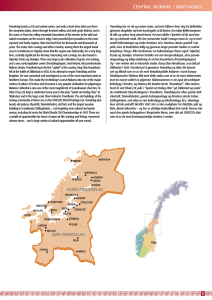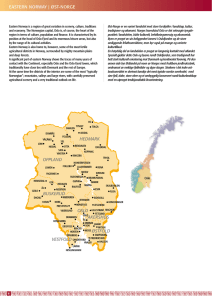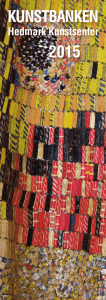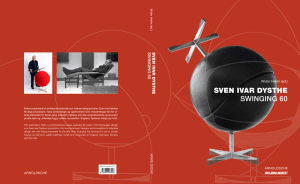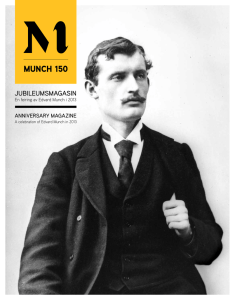ISSN 1891-0920 Nr 1- Februar 2013
advertisement
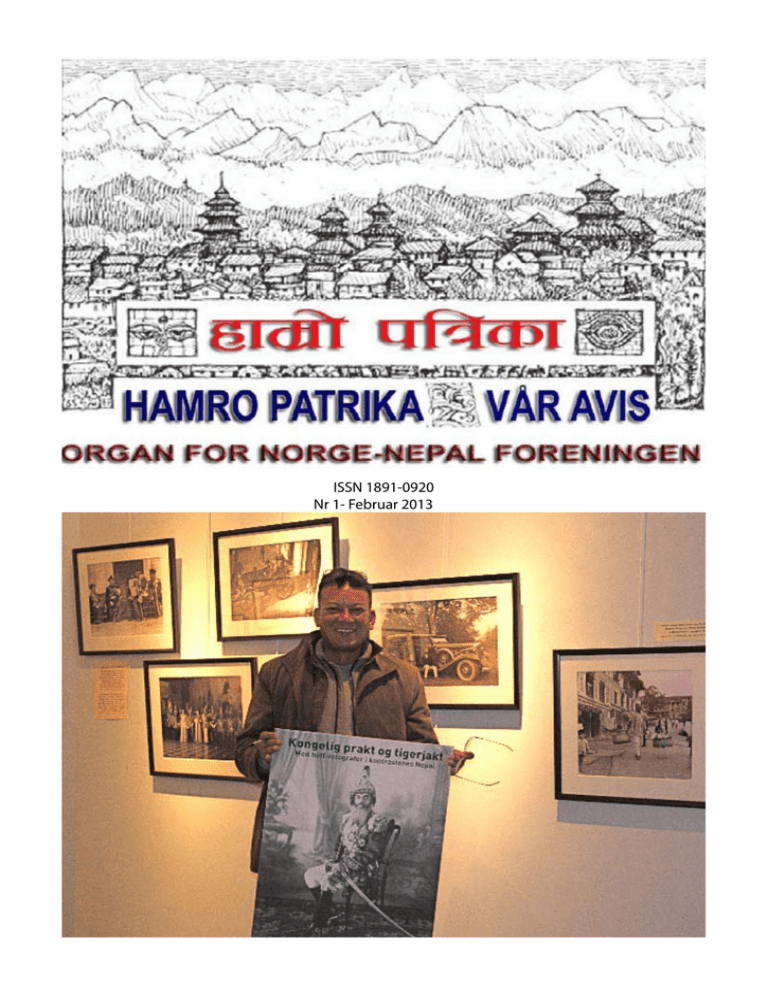
ISSN 1891-0920 Nr 1- Februar 2013 Hamro Patrika nr 1 Februar 2013 INNHOLD : Royal luxury and tiger hunting: Exhibition with photos from the Chitrakar collection 2 Seminar: Culture, Power, and Social Change in Nepal 6 Fotokonkurranse 14 Meningsfylt prosjektreise til Nepal 15 Årsmøte og medlemsmøte onsdag 3. april 18 Samtaler på norsk og nepali 18 Hva har skjedd siden sist? 19 Royal luxury and tiger hunting Exhibition with photos from the Chitrakar collection On Thursday February 7th, Fotografiens Hus in Oslo was filled with people who had come to attend the opening ceremony of the exhibition ”Royal luxury and tiger hunting”, showing photographs from the unique Chitrakar collection in Kathmandu. Having known the Chitrakar family for many years, Ane Haaland in 2011 asked the Norway-Nepal Association to organize an exhibition with photos from this collection. The board said yes, and the event on February 7th marked the end of a 1 ½ year planning period. The Norway-Nepal Association organized the exhibition, with Ane Haaland, Kiran Man Chitrakar, and Fotografiens Hus as collaborating partners. Forsiden: Kiran Man Chitrakar with photo exhibition poster. Hamro Patrika legges ut som en pdf fil på Norge-Nepal foreningens hjemmeside: www.norge-nepal.no. Medlemmer som har betalt medlemskontingent for 2011 og /eller 2012 får dette nummeret per Kiran and Ane discussing how to hang the photo graphs. The exhibition shows unique historical photos epost. Kontingenten for 2013 kan betales of the ruling elite’s luxurious life style during the til konto 6011.06.71221. Enkeltmedlem kr. first half of the 20th century. The feudal Rana fam175, familie kr. 225, organisasjon kr. 350. Redaksjon: Marit Bakke Norge-Nepalforeningens logo: Stein Fossum ily lived totally separated from the rest of society, ignoring traditional Nepali culture. Wildlife huntLayout: Dag Norling Forsidetegningen: Sigmund Setreng 2 Hamro Patrika nr 1 Februar 2013 ing in southern Nepal as well as using European inspired costumes and goods, were means for the Rana family to exclude themselves from ordinary people. Several photos that are taken at different times show the dramatic contrast between Kathmandu as it was in the middle 20th century and today. There are also photos of people in everyday activities, such as cleaning rice and maize, carrying children to the field in a basket, and a happy man getting oil massage. The photos were taken by the Chitrakar family who acted as the court’s official portrait makers during the 20th century. Dirga Man Chitrakar and his son Ganesh Man documented a very special part of Nepal’s cultural history. Ganesh Man’s youngest son, Kiran Man, continued to portray the royal family, and, after the end of monarchy in 2008, prime ministers and politicians in Nepal. For several years, Kiran Man Chitrakar has headed the group of photographers in Nepal TV. The day before the exhibition opened there was hectic activity to hang the photographs and captions. The opening ceremony was a great success with about 50 people present, including three members of the Chitrakar family: Kiran Man Chi- Photographs to be put on the walls Ane numbering the photographs trakar, his daughter Cristeena and son Swaraj. The Non-Resident Nepali Association (NRNA) in Norway had prepared delicious Nepali snacks. 3 Hamro Patrika nr 1 Februar 2013 The exhibition almost ready Terje Lie Olsen, director of Fotografiens hus, wishing welcome 4 Hamro Patrika nr 1 Februar 2013 Lena Margrethe Hasle with Kiran Man Chitrakar Terje Lie Olsen wished the audience welcome to Fotografiens Hus. Then, Lena Fauske, on behalf of the Norway-Nepal Association, said thank you to everyone who had made this excellent and fascinating exhibition possible, including the sponsors: Stiftelsen Fritt Ord, Norfund, Nomaden, Mountain People, Øyvind Bruland, and Marit Bakke. Kiran Man Chitrakar followed Lena with some words about the collection as well as expressing gratitude for facilitating this event to take place. Finally, Lena Margrethe Hasle formally opened the exhibition on behalf of the Norwegian Embassy in Kathmandu. She has been stationed in Kathmandu for three months and have already noticed that the relationship between Nepal and Norway is something special. From left: Terje Lie Olsen, Swaraj Chitrakar, Lena Fauske, Kiran Man Chitrakar, Ane Haaland, Marit Bakke, and Cristeena Man Chitrakar. Photo: Suraj Thapa 5 Hamro Patrika nr 1 Februar 2013 Photographs from the Chitrakar collection have been exhibited in England, Switzerland (Basel and Geneve), in the UNESCO headquarter in Paris, USA, Japan and India. The Norway-Nepal Association is proud to have enabled these photographs to be exhibited also in Norway. The exhibition can be seen until March 3rd in Fotografiens Hus, Rådhusgata 20, Oslo. Opening hours: Tuesday-Friday kl. 10-16; Saturday-Sunday kl. 12-16. Mondays closed. Text and photo: Marit Bakke Nepali snacks Seminar: Culture, Power, and Social Change in Nepal The seminar was held on Saturday February 9th, two days after the opening of the photo exhibition. The Norway-Nepal Association was very grateful to have the Non-Resident Nepali Association (NRNA) in Norway, and Utviklingsfondet (the Development Fund) as generous collaborating partners. The seminar was technically assisted by Sachesh Silwal (currently at Utviklingsfondet) who also took photos. We were very happy that about 60-70 people attended the seminar, and that 31 among them stayed on for daal bhat at the end of the day. In particular, it was wonderful that many Nepalis turned up, probably due to good announcement by NRNA. Thanks to Suraj Thapa and his friends in NRNA, Nepalis contributed with music and dance during breaks throughout the seminar. Suraj introduced each performer, beginning with Pasang Sampu and Krishna G. C. In her introductory remarks, Marit Bakke said that the intention of the seminar was to follow up some of the themes so well illustrated and Krishna G. C. (left) with sarangi and Pasang Sampu with madal (drum). documented in the photo exhibition. First, Kiran Chitrakar gave a brief history of the Chitrakar family’s tradition as court painters and photographers, going back to the early 19th century. The combined painter and phographer tradition was illustrated by one photo that showed a painting 6 Hamro Patrika nr 1 Februar 2013 Welcoming remarks by Marit Bakke. done by Dirgha Man Chitrakar of Prime Minister Jung Bahadur Rana. Chitrakar means artist, the one who makes pictures, and constitute a specific caste among the Newaris, the original ethnic group in the Kathmandu Valley. Dirgha Man Chitrakar (18771951) began the family tradition in 1903, first as a painter and later as a photographer, particularly after he had brought back a camera from London where he had joined prime minister Chandra Shumsher’s visit there in 1908. Today, Kiran Man Chitrakar is taking care of three thousand glass negatives from the Rana period as well as photos taken since the 1950s. Among these are photos of the Kathmandu Valley that Kiran’s father, Ganesh Man Chitrakar (1916-1985), took from a helicopter in 1955 when he was working for USAID. Kiran Man Chitrakar with a photo of his grandfather’s camera bought in London. in particular during the Rana regime. The Ranas used European inspired, partly imported, goods, architecture, and costumes to symbolize power and exclusion from ordinary Nepalis. By having Kiran Man’s daughter, Cristeena, had come photographs taken in ”exclusive” settings, their from the United States, where she has been living status and power were confirmed among themfor the last four years. She based her interesting selves as well as in the public eye. In an interview presentation on a thesis written for a BA degree with Cristeena, a young Rana man said that the at Bard College. Cristeena explained how the Chi- Chitrakar photographs documented history and trakar photographs tell a story of the relationship had little relevance today. In contrast, her father, between the image of photographs and power, Kiran Man Chitrakar, views these photos as docu- 7 Hamro Patrika nr 1 Februar 2013 Kiran showing photos of Swayambhu in 1955 and 2010. ments in an ongoing historical process. Cristeena also told about the Nepal Picture Library (www.photocircle.com.np) , a digital archive based on old and recent photos of the urban middle class. These photos contribute to creating a class specific memory as well as a middle class identity among today’s young generation. Hans Bjønness. Cristeena Man Chitrakar. After a coffe break, Professor (NTNU) Hans Bjønness introduced us to Kathmandu as ”landscapes of memory.” He began by asking the audience how many towns there are in Kathmandu. After people had replied three, five, seven, Hans 8 Hamro Patrika nr 1 Februar 2013 said: ”There are more than a millon towns in Kathmandu.” This individual perspective opens for an understanding of Kathmandu as a collective created by millions of individuals. Bjønness illustrated this argument by showing pictures of people in different physical (e.g. housing) and social surroundings. The social aspect is expressed by people belonging to various ethnic groups who live in various neighbourhoods. Some of Bjønness’ pictures showed the drastic growth that has taken place in Kathmandu during the last 20-30 years, a change also documented in the photo exhibition, and he emphasized the importance of Traditional and moderen clothing; with the very same city planning. background. Marit Bakke (Professor emeritus) put Nepal’s cultural heritage in an international perspective. During the 100 years long Rana regime, traditional temples and monuments were neglected. Therefore, the government that came to power in 1951 was faced with an immense task of restoration. Foreign architects, anthropologists, conservationists, and organizations (inlcuding UNESCO) registered sites in urgent need of restoration, while the Nepali government agencies did not get actively involved in the actual work until the middle 1960s. A strained economy is part of the explana- Photos can be saved and presented with new technology. tion, but equally important is the elite reluctance to accept the advice of foreigners who planned to put indigenous Nepali culture in the spotlight. This greatly would reduce the value of luxury goods as exclusive symbols of power. Today, 15 sites in Nepal are on the UNESCO World Heritage List (among a total of 962), sites that attract thousands of tourists with money. The same process from neglect to acceptance of indigenous culture has taken place in other countries in Asia as well as in Africa and Latin America. Another issue that these, often poor, countries have in common is who can afford or is willing to pay to preserve the Marit Bakke with a picture of everyday life in Bhaktacultural heritage. pur, a UNESCO heritage site. 9 Hamro Patrika nr 1 Februar 2013 Uttam Khanal, currently working at Utviklingsfondet, presented a broader societal perspective on Nepal. After graduating with a Masters in Agricultural Economics from Tribhuvan University he has worked in Pokhara with local initiatives for biodiversity, focusing on empowering rural poor farmers in Tanahun. Uttam talked about migration from rural to urban areas and abroad, and its consequences on land use in Nepal. The migration means fewer hands for agriculture, leading to fertile soil left barren, and ”the village turned into a jungle”. Thus people living in rural areas are left in poverty. Maps from 1976, 2001, and 2009 illustrated the drastic changes in land use in the Kathmandu Valley. Gurung raised the important issue of preserving the Chitrakar collection of 3000 glass plate negatives and thousands other photos as part of Nepal’s cultural heritage. Kiran said that the Ministry of Education had been approached several times to provide funding to create a special museum, so far in vain. He expressed his frustation by saying: ”The old paintings and pictures on the wall of the Parliament House have been covered with plywood since Nepal became a republic.” Changes in land use in Kathmandu. Photo: Suraj Thapa Uttam Khanal There were many questions from the audience. Some wanted to know how people living in rural areas outside the Kathmandu Valley, most of them not belonging to the middle class, would percieve the images presented by Cristeena. Hem An active audience asked many questions. 10 Hamro Patrika nr 1 Februar 2013 During the coffee break we were entertained with Nepali dance and music. At the end of the seminar Sriya danced more, followed by everyone joining Bodharj, Krishna, and Pasang in two Nepali songs. More questions, here from Hem Gurung. 11 Hamro Patrika nr 1 Februar 2013 During the coffee break we were entertained with Nepali dance and music. At the end of the seminar Sriya danced more, followed by everyone joining Bodharj, Krishna, and Pasang in two Nepali songs. Pralaya Rijal, a dentist, entertaining with Nepali songs. Sriya Pariwar contributed with beautiful Nepalese dance. Bodhraj Khanal, Krishna G.C., and Pasang Sampu (from left) got big applause from the audience, which joined in the singing. 12 Hamro Patrika nr 1 Februar 2013 And then there was time for daal bhat and good conversation. Daal bhat. Text: Marit Bakke Photo: Sachesh Silwal (except where another name is given) A proud team finished the cleaning job: Sachesh Silwal, Uttam Khanal, Suraj Thapa, and Krishna Sapkota. Photo: Kabita Sapkota 13 Hamro Patrika nr 2 -2012 Fotokonkurranse Norge-Nepalforeningen inviterer alle sine medlemmer og andre til en fotokonkurranse med temaet «Katmandu - før og nå» I forbindelse med fotoutstillingen “Royal luxury and tiger hunting” og seminaret som NNF nettopp har holdt inviterer vi til en fotokonkurranse med temaet: «Katmandu - før og nå». Vi ønsker bilder fra dagens Katmandu, gamle bilder fra Katmandu, eller både før og etter bilder av samme sted i Katmandu. Hverdagsliv, landskap eller bygninger kan være motiv, det er opp til deg! Legg også ved en liten beskrivelse av bildet / bildene. Send bildene (max 4 per person) til leyla.r.kutlu@gmail.com før 6. mars. De 3 beste fotografiene blir trykket i Hamro Patrika og vil bli brukt på vår hjemmeside med tillatelse fra fotografen. Premiene er: 1. Et lite fotografi fra fotoutstillingen. 2. En dagstursekk fra Bergans. 3. En rumpetaske fra Bergans. 14 Hamro Patrika nr 2 -2012 Meningsfylt prosjektreise til Nepal Testing av folks syn for å forbedre levekårene på landsbygda Anne Grythe Brandsnes, styremedlem i Vision for All, i Peru. Foto: Vision for All I månedsskifte april-mai setter Ethical Travel Portal og Vision for All seg på flyet i retning Nepal. Her skal vi være i to – tre uker og bidra på en meningsfylt måte. Ethical Travel Portal er en reisearrangør som skreddersyr turer med fokus på ansvarlig turisme; sørge for å skape mest mulig økonomisk vekst på våre reisemål, være engasjert i lokalsamfunn og å ta miljø- og samfunnsansvar der hvor vi ferdes. Nepal er en av våre kjæreste reisemål. Vision for All ble startet i Sverige i 1995 av optiker John J. Godoy. Godoy er opprinnelig lærer fra Peru og oppdaget etter hvert at flere av elevene hans hadde dårlig syn. Etter å ha giftet seg med en svensk dame, utdannet han seg til optiker i Sverige og begynte å ta med seg briller på hver tur hjem til Peru. Den norske avdelingen ble grunnlagt i 2003 av en gruppe optiker-studenter med Gunnar Lindgren i spissen. Det er også avdelinger i Danmark, Finland og Italia. Vision for All er en frivillig organisasjon som jobber blant fattige som trenger hjelp av optikere og som ikke kan betale for en synsundersøkelse eller skaffe seg briller. Mennesker som er svaksynte eller blinde, men som med de rette hjelpemidlene vil kunne se. Synstester på landsbygda Nå har Ethical Travel Portal og Vision for All slått sammen sin ekspertise og i partnerskap arrangere vår første prosjektreise til Nepal. Vi gleder oss! På landsbygda i Nepal setter vi opp mobile øye-klinikker og gir lokalbefolkningen mulighet til å få synet sjekket av optikere. Et godt syn kan 15 Hamro Patrika nr 2 -2012 Karin Veråsdal hos en vertsfamilie i Chitwan. Linda Veråsdal Foto: når de er med på prosjektreise. Og et så fantasha mye å si for å kunne skaffe seg den daglige tisk vakkert land som Nepal må jo bare oppleves inntekten. Vi har fokus på barn og kvinner under gang på gang! reisen. Underveis bor vi privat hos familier. Vi skal besøke to landsbyer. Den første er Dhaubadi som ligger ca 211 km sør for Kathmandu. Den andre landsbyen vi skal besøke er Susta som ligger helt i sør ved grensen til India. I hver landsby skal vi ha tre arbeidsdager og satser på å ta 100 synstester per dag. Det vil da bli totalt 600 synstester på reisen. Fra Norge tar gruppen med innsamlete briller som kan deles ut etter behov. Hvis noen trenger briller som vi ikke har med, vil vi sørge for å få dem tilpasset i Nepal. Vi har et godt partnerskap med lokale krefter i Nepal gjennom øyespesialisten Dr Suman Thapa, Raj Gyawali og Socialtours. I landsbyen Hattibang, på vei til Chitwan. Foto: Fredrik Pettersen Mellom de to landsbyene vi skal besøke ligger Chitwan National Park. Her vil vi tilbringe et par Har du lyst til å være med? dager for å samle krefter til neste arbeidsøkt og Har du en drøm om å reise til Nepal eller kanlandsby. Et hyggelig stoppested langs ruten! Etter siste arbeidsøkt er det også mulig å forlenge skje gjøre noe meningsfylt der? Med på reisen har reisen. Erfaringsmessig er dette noe de fleste gjør vi optikere og assistenter. Alle har mulighet til å være med som assistent uten nærmere erfaring. 16 Hamro Patrika nr 2 -2012 Men vi trenger også flere optikere med på turen. Vi satser på å få til en tur i året. Dersom du er interessert, send gjerne en e-post til linda@ethicaltravelportal.com, så setter vi deg på listen for oppdatering og informasjon. Linda Veråsdal Daglig Leder, Ethical Travel Portal www.visionforall.no www.ethicaltravelportal.com Barn på en skole i Chitwan. Elefanter bader i Chitwan. Alle foto: Fredrik Pettersen På kanotur i Chitwan i 2009. 17 Hamro Patrika nr 2 -2012 Årsmøte Det innkalles til årsmøte i Norge-Nepalforeningen Onsdag 3. april kl. 18.30. Sted: Batteriet, Fredensborgveien 24 A, Oslo. Forslag som ønsket behandlet på årsmøtet må være sendt til styret senest 20. mars. Send en e-post til styreleder Lena Fauske: lenafau@online.no To styremedlemmer går ut av styret. Forslag på kandidater sendes til valgkomiteen v/ Trude Berget: trude.berget@broadpark.no eller Anuradha Gurung: anuradha.gurung.amundsgard@dnv.com Medlemsmøte med Hvitserk Onsdag 3. april Etter årsmøtet forteller Trygve Sunde Kolderup fra Hvitserk om turoperatørens engasjementer i Nepal der turer kombineres med frivillig arbeid. Hvitserk er Norges ledende arrangør av eventyrlige reiser og krevende ekspedisjoner. I de senere år er de blitt spesielt opptatt av Nepal, ikke minst for å bidra sosialt i forbindelse med sine turer. Hvitserk er en av Norge-Nepalforeningens samarbeidspartnere, se HP nr. 3, 2012. Vi avslutter møtet med daal bhat. Pris 200 kr. Påmelding gjerne før påske, aller senest den 2. april til: marit.bakke@media.uib.no Samtaler på norsk og nepali Uttam Khanal, Sachesh Silwal (begge arbeider for tiden i Utviklingsfondet) og styremedlemmer i Norge-Nepalforeningen planlegger uformelle sammenkomster for at nepalere kan øve seg i norsk og nordmenn få anledning til å øke sine kunnskaper i nepali. Planen er å møtes i Oslo sentrum, flere praktiske detaljer avhenger av hvor mange vi blir. Er du interessert, send en e-post til Leyla Kutlu: leyla.r.kutlu@gmail.com 18 Hamro Patrika nr 2 -2012 Hva har skjedd siden sist? For å komme ut av den politiske stillstanden har Baburam Bhattarai sagt seg villig til å ga av som statsminister og bli erstattet av et valgforberedende råd (”electoral government”). De politiske partiene er blitt enige om å utnevne Chief Justice Khil Raj Regmi som leder av Election Administrative Council. Idet HP går til layout den 25. februar nøler fortsatt Regmi med å si ja fordi han vil at utnevnelsen skal være uten betingelser og at han frykter å bli en nikkedukke i et politisk spill. The Nepal Bar Association har uttrykt bekymring over sammenblandingen av det politiske og juridiske system som en slik utnevnelse innebærer. Det er mange som har etterlyst et juridisk oppgjør etter den ti år lange konflikten; at de som drepte sivile blir ettersøkt og stilt for retten. Det er eksempler på at slikt skjer. I 2004 forsvant radiojournalisten Dikendra Thapa og mange antok at han var drept. Nesten syv år senere fulgte en politimann opp saken og arresterte fire av de som var involvert i torturering og drapet på Dikendra Thapa. Regjeringen med statsminister Bhattarai i spissen hevder at vold utført under krigen var politisk og bør undersøkes og behandles av en fremtidig Sannhets- og forsoningskommisjon. Men ingen skal føle seg trygge. I begynnelsen av januar ble oberst Kumar Lama arrestert i London, anklaget for krigsforbrytelser. Den nepalske regjeringen var ikke varslet på forhånd og kritiserte de britiske myndighetene for blande seg i Nepals interne forhold. I begynnelsen av januar intervuet Nepal Samacharpatra tidligere kronprins Paras, Gyanendras sønn, i Thailand. Han avviste beskyldninger om ulovlig virksomhet i Thailand som forsøk på å ødelegge hans rykte. Han mente at Nepal trenger et sterkt nasjonalistisk lederskap, uten dermed å si at monarkiet burde gjenopprettes. En måned etter dette intervjuet ligger Paras i koma etter et kraftig hjerteinfarkt. Annet nytt: • I begynnelsen av februar deltok ambassadør Ramslien under lanseringen av magasinet Southasian som skal utgis kvartalsvis med norsk støtte. • Sosiale medier spiller en viktig rolle for å gjøre oppmerksom på, og forebygge, vold mot kvinner i Nepal. • Det er over 200 private forskningsinstitusjoner i Nepal. På flere universiteter er ansatte bekymret over økt politisk innblanding, blant annet i ansettelser. Dette har skjedd både ved Tribhuvan University’s Centre for Economic Development and Administration (CEDA) og Patan Academy of Health Sciences (PAHS). • Eldbjørg Nyborg i Sansereiser har sendt oss nye kontaktadresser: http:// sansereiser.blogspot.com www.pbase. com/eldnyb http://epla.no/shops/sanserommet Marit Bakke 19


